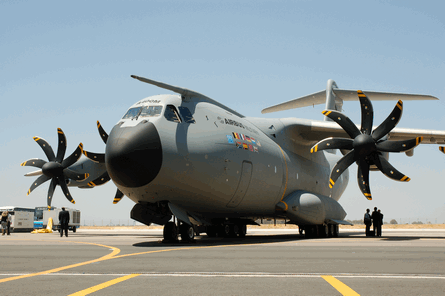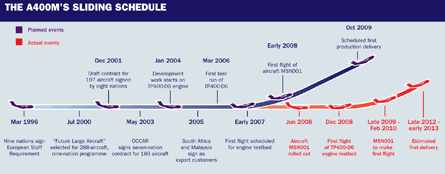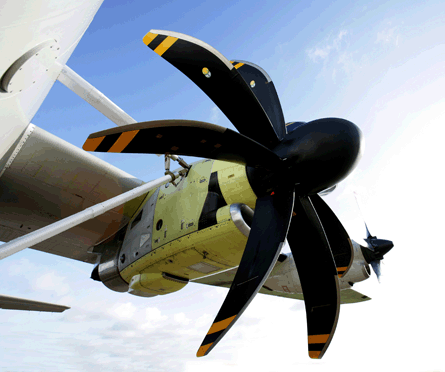Under original plans, this year's Paris air show should have been a time of major celebration for Airbus Military, coming just four months before it was due to deliver its first production A400M transport to the French air force.
In reality, the €20 billion ($28.3 billion) project is running about three years late, has yet to achieve flight status, and is scrabbling to secure a commitment from its seven launch partners to continue with development activities. Now nearing the end of a three-month moratorium period that began after the nations agreed to waive a 31 March termination clause, Europe's largest collaborative defence project could be on the brink of collapse.
 |
|---|
© Airbus Military |
TWO TUBULENT YEARS
The last time it was at Le Bourget, EADS-led Airbus Military maintained an optimistic front about the airlifter's prospects, although its first flight target of early 2008 already looked sure to slip. Within months, the programme had unravelled, with much of the blame focused on the late availability of the A400M's Europrop International TP400-D6 turboprop engines.
Underlining its troubled past two years, the programme has also undergone two leadership changes since mid-2007, most recently in February, when Domingo Ureña - an architect of Airbus's "Power 8" restructuring programme - became its new managing director.
In a related bid to revive its fortunes, Airbus Military is now a full part of Airbus, with its transition to be complete by 1 January 2010. "It was clear that we needed to improve the way of making decisions," says Ureña, referring to a previous disconnect between the parent company and the then-EADS Military Transport Aircraft Division. "Now there is only one fully accountable for this programme - profit and loss."
EADS concedes that it was wrong to treat the 180-aircraft A400M deal - contracted only in May 2003 - like any other commercial Airbus programme: a key selling point of its campaign to deliver the Future Large Aircraft.
 |
|---|
"Historically, Airbus has always performed in the same way, but with the A400M the customer was completely different, and we wanted to incorporate unprecedented technology," says Ureña. "That has been the difficulty that industry is facing." Vital engineering resources were also lost to the commercial demands of the A380 and A350 projects, he adds.
"We underestimated the military aspect of an aircraft like this," says Ureña. "We underestimated the potential technological challenge in the engine side and some of the systems that we have on the plane."
Writing in the UK's Financial Times newspaper on 29 May to mark the 40th anniversary of Airbus's creation, Airbus chief executive Tom Enders said: "Industry must now show what contributions it is prepared to make to deliver what was promised on the A400M."
The governments of Belgium, France, Germany, Luxembourg, Spain, Turkey and the UK should show "political courage" by keeping faith with the project, said Enders, and demonstrate "a greater degree of realism in order to enable delivery of the aircraft we all want at a sensible price". About 40,000 European jobs depend on the project's survival, he cautioned.
 |
|---|
Enders also used the article to slam what he called a tendency among European military requirements for "defending diverse national requirements that offer little in terms of performance, but impact significantly on cost and deliverability". He was referring largely to the political motivations that led to the choice of an engine involving European propulsion specialists ITP, MTU Aero Engines, Rolls-Royce and Snecma.
Some - such as France, Germany, Spain and Turkey - appear willing to back this rallying call, but the UK in particular has so far refused to agree to increase spending or cut back on contracted capabilities under the fixed-price deal. Its Ministry of Defence last month said it remained committed to the project, "but not at any cost", and revealed it had been told the transport would make its first flight between late this year and February 2010, pushing the first UK delivery to 2013.
FLIGHT-TEST INSTRUMENTATION
Having been rolled last June in basically complete form at Airbus Military's San Pablo site near Seville, Spain, aircraft MSN001 has now been equipped with 20t of flight-test instrumentation, including five on-board work stations. The aircraft is scheduled to go to outside test once its TP400s have been installed with their flight-standard full-authority digital engine control software, and Ureña says ground runs with the propulsion system will start in the "mid-summer".
"Despite these unprecedented technological challenges and an unrealistic timescale, we have aircraft number one mature enough for its first flight," says Ureña. The programme's second aircraft achieved its power-on milestone in April, and systems testing will begin soon. The fuselage mate for the third example was due to take place in mid-May, following the arrival of the main fuselage section from Bremen, Germany.
The nations are in a difficult position, because Airbus Military says it will not be able to give them firm cost information or delivery dates until its test fleet is into a "mature" flight campaign. Also, only at this point will it be able to determine whether several of the A400M's crucial performance goals outlined in the 1996 European Staff Requirement and May 2003 launch contract are to be met.
 |
|---|
"We can confirm that some of the key performance of the aircraft will be according to the specification, and some will be over the specification," says Ureña. "But they will have some shortfall in certain areas. We have certain functionalities that we don't know how to certify, so I cannot maintain these."
Ureña says dialogue is needed with the nations during the moratorium period to explain to them that the technology required to deliver some of the programme's contracted elements is not currently available. "They don't have to agree, but they need to understand, and build a new programme."
But the Airbus Military boss denies reports that the A400M is unable to meet its payload requirements, noting there is actually no contracted maximum figure. "We have, like any aircraft, weight issues," he confirms, but says a weight optimisation programme has already been identified for service-standard aircraft. "I believe we can maintain our commitment on payload/range [performance] as in the original contract," Ureña insists.
Previous marketing material released by the company has described a requirement for a baseline lift capacity of 32t, falling to 25t for tactical operations. Earlier forecasts have talked of the A400M delivering a capability of 37t and 29.5t, respectively, and Airbus Military's vice-president defence capability marketing, Peter Scoffham, confirms: "There is still margin. We would be crazy to build to the exact specification."
Airbus hopes to have a commitment in place from the nations in time for the air show, and has pledged to continue funding development activities until year-end to give them enough time to reach a contractual agreement to complete the project.
"I am an optimistic person, and I believe we have the right product," says Ureña. "We could take Europe with this kind of aircraft to primacy for the next 20 to 30 years in this sector. It would be unfortunate if we walk away from a programme like that."
INDUSTRY PLAYS CATCH-UP WITH THE TP400
The propulsion system for the Airbus Military A400M has been the focus of great attention since the last Paris air show, with delays in its availability contributing to a first flight slippage of potentially two years from early 2008.
Representing one of the biggest technical challenges for the A400M programme, the 11,000shp (8,200kW) TP400-D6 is the responsibility of Europrop International (EPI) - a consortium formed of ITP, MTU Aero Engines, Rolls-Royce and Snecma.
Development work was launched in early 2004, and is now about 90% complete. Six engines have amassed more than 2,950h in bench tests, and a seventh has logged 35 flight hours in 12 sorties between last December and late May. Its 50h campaign should conclude in mid-July.
 |
|---|
© Airbus Military |
"We've got a pretty good engine," says EPI president Nick Durham. "Performance and weight results pretty much meet our wildest dreams." The turboprop is operating within maximum temperature margins, meeting specified fuel consumption targets and is just 1% above its specified weight target of 1.9t, he adds.
The TP400 was theoretically ready to fly on the A400M after aircraft MSN001's roll-out last June, but an astonishing administrative error prevented this from happening.
Speaking last month, Durham revealed that EPI realised it was unable to meet a key certification requirement by demonstrating the traceability of the TP400's full-authority digital engine control software to European civil standards, so had to start again. "For a time we didn't realise that we had an issue," he says, attributing the oversight to "the pressure of the moment".
EPI tripled the number of engineers dedicated to the project, and flight-standard FADEC software was due for delivery in mid-May. An audit of the programme is set for mid-year, with certification targeted for completion late this year.
AIRBUS INTEGRATION UNITES TRANSPORT FAMILY
Following its integration within Airbus in April, Airbus Military now also oversees the production of the light and medium transport products of the former EADS Casa, plus upgrade and tanker programmes.
The company's San Pablo site near Seville, Spain, is dominated by its A400M final assembly line, but there is also a 14,000m² (150,700ft2) hangar to complete C-212, CN-235 and C-295 airframes.
Inaugurated in mid-January to assemble up to 24 aircraft a year, but with space to grow this to 35, the latter has increased capacity by 25% over the maximum possible using the previous build hall. Four assembly stations are used, with a fifth dedicated for modernisation activities.
 |
|---|
© Airbus Military |
Portuguese air force C-295s are being assembled, and CN-235s are in build for Botswana and US company L-3 Communications. There is a backlog to build a combined five C-212s for Thailand and Vietnam, and the Czech Republic last month signed for four C-295s, to be delivered from late this year.
Work was due for completion in late May on the first maritime patrol example of the C-295 for Portugal, carrying a palletised version of the EADS Casa-developed fully integrated tactical system mission suite. The scaleable system is also being integrated on to Lockheed Martin P-3 Orions for Brazil, with its first of nine modified aircraft having flown in April.
Major activities are also occurring in the tanker sector, despite Washington's cancellation last year of a US Air Force deal to buy modified Airbus A330-200s. The type remains EADS's intended offering for a revived KC-X contest. Flutter testing of its advanced boom refuelling system has concluded recently.
The work was performed using Australia's first of five A330-based multi-role tanker transports, which has also recently undergone receiver trials with a French air force Boeing KC-135 (above), and made dry contacts with a fighter using its under-wing hose and drogue refuelling pods.
Meanwhile, the UK's first of 14 A330s to be modified as Future Strategic Tanker Aircraft will soon arrive in Getafe, near Madrid, for preparation for air-to-air refuelling tasks.
- All the latest news, images and video from the Paris Air Show
Source: Flight International



















